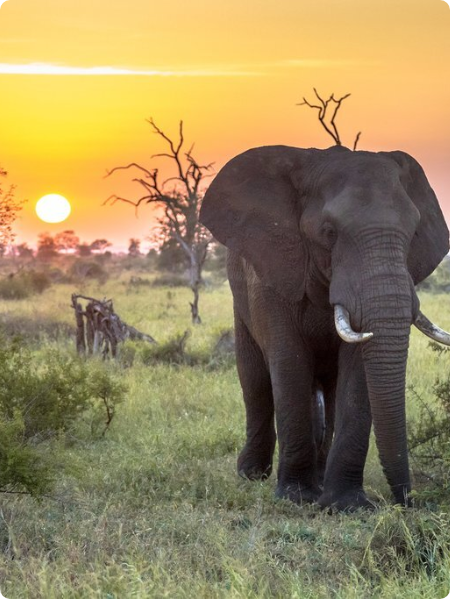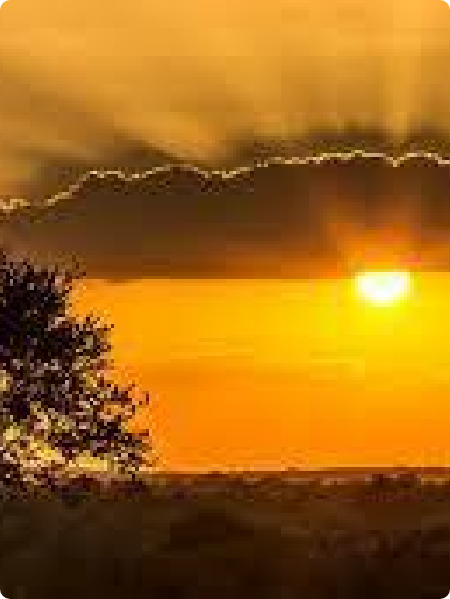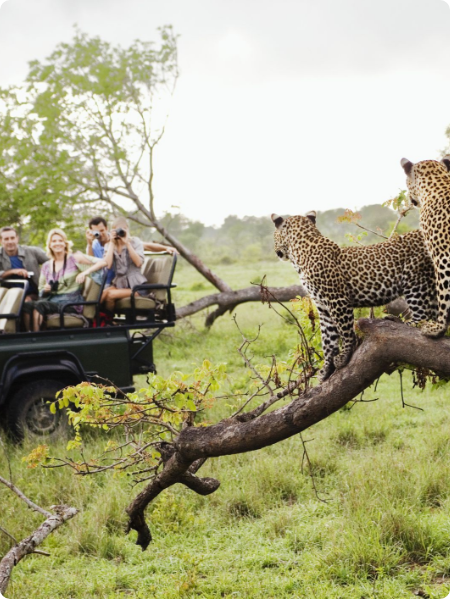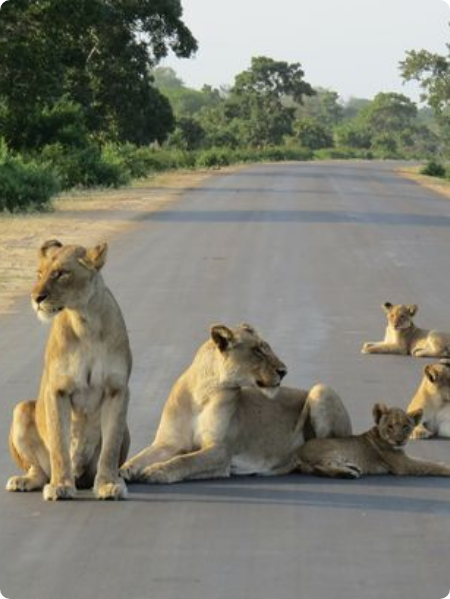Park overview
It is stated that you haven’t experienced the beauty of Africa yet if you haven’t toured Kruger National Park in South Africa. Filled with iconic, historical, and legendary features, landscapes and wildlife, it is the literal definition of a Spectacular Safari Tour! Indeed, Kruger is the crown jewel of the South Africa National Park system.
The park is a habitat for Africa’s Big Five: Lion, Leopard, Elephant, Rhino, and Buffalo. The park offers executive accommodation and outstanding tour packages that will fill your vacation with memorable situations. It hosts tourists in luxurious safari lodges and beautiful opulent tents pinned in camps for family, group or team retreats.

The Kruger Park covers a vast area of 19,485 square km (12,107 mi) in Limpopo and Mpumalanga Provinces, in far north-eastern South Africa. It also extends 220 miles north towards the south and 40 miles east to west of the Country. Kruger is the first National Park in South Africa to be located and protected by the government. Its boundaries were formed as a reserve in 1898, and it was made a National Park in 1926. Since then, it has been part of Kruger to Canyons Biosphere designated by the UN educational, scientific and Cultural Organization (UNESCO).
The park comprises nearly two million hectares and also offers beautiful scenes of rivers within it, the Olifants, Sabie, Crocodile, Luvuvhu, Letaba, and Limpopo rivers all find a home in the Kruger National Park. Their slithery, slow, flowing movements will amaze you, especially when seen from an aerial view. Just magnificent! The climate surrounding the park is the subtropical climate which exhibits summer days that are hot and humid. It is advised to visit the seasons that are favorable for you, its rainy from the end of September to May and driest in October. The Park is home to vegetation such as the Thorn trees, Knob-thorn, Marula Veld, red bush-willow veld, Mopane veld, and Shrub Mopane Veld.
Kruger is also home to more than 110 species of reptile, including many species of poisonous snakes. The park has thousands of crocodiles. The transvaal flat gecko and Turner's thick toed gecko also reside here. If you are sharp-eyed you may spot the shortfooted burrowing skink, a giant plated lizard, Barberton girdled lizard, a Rock leguaan, the common African python or the dangerous black mamba.
The best of the park's safari tours are the amazing animals, which include Giraffes, Antelopes, Crocodiles, Warthog, Waterbucks, endangered African Wild dogs, Greater Kudu, Impalas, Lichtenstein’s hartebeest, Mountain Reedbuck, Bushbuck, Blue wildebeest and most of all the Burchell’s Zebra in addition to the Big Five! The park is larger than Israel and is home to 500 species of birds, 116 reptiles, 34 amphibians, 49 fishes, 457 types of trees and shrubs, 1,500 smaller plants, and countless insects.
The Park, or The Kruger as it is known to locals, has an extensive all-weather road system that allows for tourists to explore on their own without the need of a paid guide. According to the park's website, even the most popular national parks in the United States cannot equal the number of rest camps and the extent of the road network. This fact alludes to an apparent contradiction: South Africa's largest wildlife reserve and one of its most unspoiled wildernesses is at the same time one of the most developed and accessible ecotourism destinations in the world.
All this in unison is the reason you need a vacation to South Africa’s Kruger National Park.
Meet The Animals Up Close
Kruger is truly one of the world's premier game-watching destinations. It is home to the Big Five (cape buffalo (2,500), elephant (more than 16,000), rhino (5,000 black and white), lion (1,500) and leopard (1,000), as well as the little five (buffalo weaver, elephant shrew, leopard tortoise, antlion, rhino beetle). There are a little more than 400 of the endangered and multi-colored African wild dogs in the park.

Lions can be found scattered throughout the park, but are most commonly found in the grasslands. Oftentimes visitors can see these large carnivores preying on one of the park's zebra or wildebeest.
Leopards are one of the most elusive of all mammals in Kruger. They hunt at night. When they do venture out during the day, they often blend in to the landscape making them hard to spot to the untrained eye.
Cheetahs, however, can often be seen in the park's grasslands hunting for prey. The cheetah is the fastest animal on earth capable of reaching speeds of up to 75 km/h (46.6 miles/h).
There are other animals, large and small, not to be missed. These include giraffe, zebra, waterbuck, warthog, Heyna and Hippopotamus.
There are countless antelope, impala and kudu.
EXPLORE THE PLANT LIFE
Almost the entire stretch of the north-eastern part of Kruger National Park is covered in shrub mopane. Its scientific name is Colophospermum mopane, but it is more commonly known as mopane, mopani, balsam tree, butterfly tree, or turpentine tree. Ironically, it is part of the legume family and only grows in hot, dry, low-lying areas. It also only grows in Africa. The tree's distinctive butterfly-shaped (bifoliate) leaf and thin seed pod make it easy to identify.
Red bush-willow and mopane veld can be found in the western half of the park, but north of the Olifants River. Thorn trees and red bush-willow veld are mostly found between the western boundary and the center of the park south of Olifants River. Combretums, such as the red bush-willow (Combretum apiculatum), and Acacia species predominate while there are a great number of marula trees (Sclerocarya caffra). The Acacias are dominant along the rivers.
South of the Olifants River, mostly in the eastern half of the park, you'll find Knob-thorn and marula veld. This area also provides the most important grazing-land. Species such as red grass (Themeda triandra) and buffalo grass (Panicum maximum) predominate while the knob-thorn (Acacia nigrescens), leadwood (Combretum imberbe) and marula (Sclerocarya caffra) are the main tree species.
There are a other plant species in the park that may catch your eye. The Pretoriuskop sourveld and Malelane mountain bushveld receive relatively high rainfall. Here sickle bush and silver cluster-leaf (Terminalia sericea) are prominent. The sandveld communities northeast of Punda Maria are equally distinctive, with a wide variety of unique plant species. The bush-clad hills along the Levuvhu River also shelter an interesting floral diversity and some near-endemic species.
MEET THE BIRDS OF KRUGER
The Kruger is home to more than 500 species of birds. At least 253 of these are permanent residents. Another 117 are non-breeding migrants and 147 are nomads. Six of these species have been tagged with the moniker "Big Six Birds of Kruger." The Big 6 are: martial eagle, saddle-billed stork, lappet-faced vulture, kori bustard, ground hornbill and the hard-to-spot Pel's fishing owl. A survey in 2011 found 22 martial eagle nest sites and another survey in 2015 found an additional 17. In 2020, the survey found 70 nesting sites, so the population is definitely growing. The park is home to 25-30 breeding pairs of saddle-billed stork. In 2012 the park's staff estimated there were 178 family groups of ground hornbills.
Ornithologists will also be pleasantly surprised by the presence of the bat hawk, sanderlings, grey Plover, damara tern, cape wagtail, plum colored starling, brown headed parrot, black headed oriole, bateleur eagle, crested barbet, cormorants, purple roller, scops owl, kingfishers, perl spotted owl and the marabou stork.
Amphibians
There are at least 35 different species of amphibians that call Kruger National Park home. These evolutionary links between reptiles and fish that emerged from the oceans roughly 400 million years ago, include the African bullfrog, the tiny baby Bushveld rain frog, the Eastern Olive toad, grey foam-nest tree frog, marbled sand frog, and lots of salamanders.
Safety restrictions
Kruger is currently within the malaria endemic zone of South Africa. It is highly recommended patrons get anti-malarial drugs. It is important to note that the risk of malaria in Kruger National Park is usually low, even in the summer months when mosquitos are prevalent. Remember to always carry bug spray. Spray all over your body, including around your ankes. All of Kruger's lodging is netted to mitigate mosquito intrusion.
Park Info
Petting zoos ‘a breeding ground for drug-resistant superbugs’
‘Skeletal’ baby elephant made to bang head to music as tourists laugh
Penguins stolen from zoo discovered two months later
Lion kills zoo worker in 'terrible accident' at wildlife centre
Small birds, fish, frogs and insects killed in Chester Zoo fire
Animals and visitors evacuated from Chester Zoo after fire breaks out







